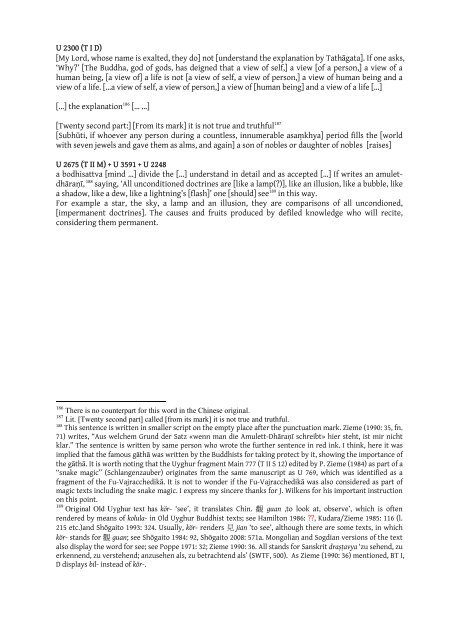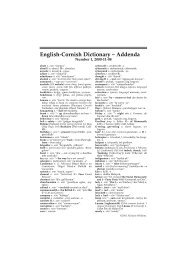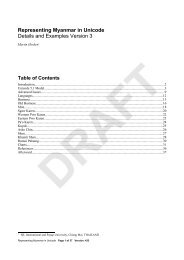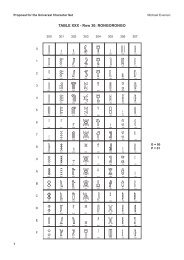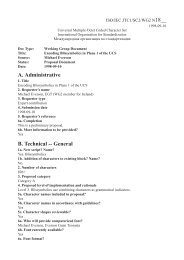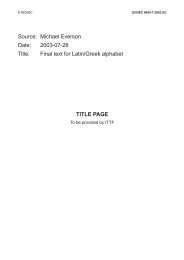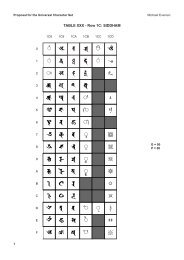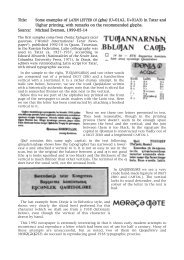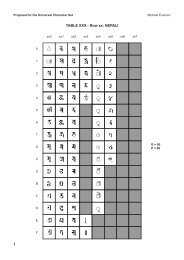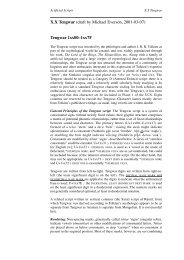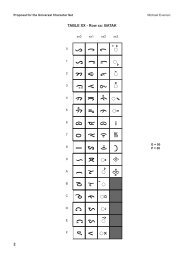The Vajracchedikā-sūtra with gāthās compiled by Master Fu - Evertype
The Vajracchedikā-sūtra with gāthās compiled by Master Fu - Evertype
The Vajracchedikā-sūtra with gāthās compiled by Master Fu - Evertype
Create successful ePaper yourself
Turn your PDF publications into a flip-book with our unique Google optimized e-Paper software.
U 2300 (T I D)<br />
[My Lord, whose name is exalted, they do] not [understand the explanation <strong>by</strong> Tathāgata]. If one asks,<br />
‘Why?’ [<strong>The</strong> Buddha, god of gods, has deigned that a view of self,] a view [of a person,] a view of a<br />
human being, [a view of] a life is not [a view of self, a view of person,] a view of human being and a<br />
view of a life. […a view of self, a view of person,] a view of [human being] and a view of a life […]<br />
[…] the explanation 186 [… …]<br />
[Twenty second part:] [From its mark] it is not true and truthful 187<br />
[Subhūti, if whoever any person during a countless, innumerable asaṃkhya] period fills the [world<br />
<strong>with</strong> seven jewels and gave them as alms, and again] a son of nobles or daughter of nobles [raises]<br />
U 2675 (T II M) + U 3591 + U 2248<br />
a bodhisattva [mind …] divide the […] understand in detail and as accepted […] If writes an amuletdhāraṇī,<br />
188 saying, ‘All unconditioned doctrines are [like a lamp(?)], like an illusion, like a bubble, like<br />
a shadow, like a dew, like a lightning’s [flash]’ one [should] see 189 in this way.<br />
For example a star, the sky, a lamp and an illusion, they are comparisons of all uncondioned,<br />
[impermanent doctrines]. <strong>The</strong> causes and fruits produced <strong>by</strong> defiled knowledge who will recite,<br />
considering them permanent.<br />
186 <strong>The</strong>re is no counterpart for this word in the Chinese original.<br />
187 Lit. [Twenty second part] called [from its mark] it is not true and truthful.<br />
188 This sentence is written in smaller script on the empty place after the punctuation mark. Zieme (1990: 35, fn.<br />
71) writes, “Aus welchem Grund der Satz «wenn man die Amulett-Dhāraṇī schreibt» hier steht, ist mir nicht<br />
klar.” <strong>The</strong> sentence is written <strong>by</strong> same person who wrote the further sentence in red ink. I think, here it was<br />
implied that the famous gāthā was written <strong>by</strong> the Buddhists for taking protect <strong>by</strong> it, showing the importance of<br />
the gāthā. It is worth noting that the Uyghur fragment Main 777 (T II S 12) edited <strong>by</strong> P. Zieme (1984) as part of a<br />
“snake magic” (Schlangenzauber) originates from the same manuscript as U 769, which was identified as a<br />
fragment of the <strong>Fu</strong>-<strong>Vajracchedikā</strong>. It is not to wonder if the <strong>Fu</strong>-<strong>Vajracchedikā</strong> was also considered as part of<br />
magic texts including the snake magic. I express my sincere thanks for J. Wilkens for his important instruction<br />
on this point.<br />
189 Original Old Uyghur text has kör- ‘see’, it translates Chin. 觀 guan ‚to look at, observe’, which is often<br />
rendered <strong>by</strong> means of kolula- in Old Uyghur Buddhist texts; see Hamilton 1986: ??, Kudara/Zieme 1985: 116 (l.<br />
215 etc.)and Shōgaito 1993: 324. Usually, kör- renders 見 jian ‘to see’, although there are some texts, in which<br />
kör- stands for 觀 guan; see Shōgaito 1984: 92, Shōgaito 2008: 571a. Mongolian and Sogdian versions of the text<br />
also display the word for see; see Poppe 1971: 32; Zieme 1990: 36. All stands for Sanskrit draṣṭavya ‘zu sehend, zu<br />
erkennend, zu verstehend; anzusehen als, zu betrachtend als’ (SWTF, 500). As Zieme (1990: 36) mentioned, BT I,<br />
D displays bil- instead of kör-.


